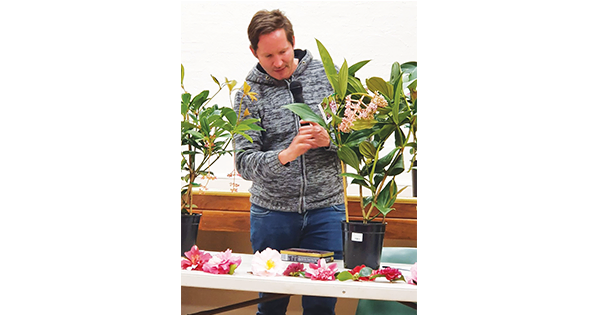The Galston District Garden Club are well and truly back up and meeting regularly on the 2nd Wednesday of the month.
Our next meeting is on the 13th July and all are welcome as members, new members or even those of you that would like to visit and experience what our members enjoy each month. We meet in the Galson Community Hall, 37 Arcadia Road, and Galston at 7.30pm.
Our guest speaker for June was Mark Massey, of Mother Earth Nursery at Kenthurst. Mark has spoken at our meetings before and a more enthusiastic horticulturalist you will ever meet. Since his last talk to the Club.
Mark has expanded his nursery at Kenthurst to another nursery at Cranebrook on three acres, a lot more room for Mark to expand his interest in cultivating and propagating unusual plants. His passion is to bring back older varieties of plants into cultivation, such as Gardenia Tipachinias, Hydrangeas, Begonias just to name a few.
One night Mark bought along a variety of plants from his nursery to show us. One plant in particular was the Medinilla, often referred to as the “rose grape”. A most unusual plant that not many of the members had knowledge about, and were most interested in here Mark explain its origins propagation and care.
Apparently, after flowering, they produce bright pink berries that look like decorative bunches of grapes. They are easy to grow, indoors or outdoors. Just give them a protected position with bright light and not too much water. I am sure a visit to Mark’s nursery at Kenthurst will be very inspiring. There is a café next door to whet your appetite too.
MEDINILLA PLANT: Medinilla is a tropical broadleaf evergreen plant. If you have travelled through Southeast Asia, you may have marvelled at this tropical beauty growing on tree branches, dangling its vivid flower panicles down like clusters of otherworldly grapes. Leaves are ribbed and moderately succulent. The average size of a Medinilla shrub is around a meter, but you can keep the plant at a reasonable indoor size by pruning it after flowering. An added bonus to growing Medinillas outdoors is their appeal to birds, bees, and butterflies.
Medinilla plants can be epiphytic in the rainforest, which means they grow on trees or shrubs instead of in the ground. In this environment, the Medinilla uses its host for support but is not parasitic- it does not draw nutrients from or harm the host plant.
When growing as a potted specimen, you can use a commercial planting medium for orchids, which resembles something like chunky bark. This allows air circulation around the roots, which prevents root diseases. An orchid pot, which contains extra ventilation holes, is also well suited for a Medinilla specimen. In appropriate climates, Medinilla plants can also grow outdoors in well-drained soil.
All Medimillas grow best in dappled shade: direct sun will scorch the leaves or cause leaf drop. Consider the Medinilla’s habitat: as it grows nestled in the lower branches of large trees in the jungle, it receives dappled sunlight: you should try to provide similar conditions.
The Medinilla is a light feeder, and excessive nitrogen will cause the plant to produce lush foliage at the expense of the blossoms. An occasional feeding with liquid compost will give the plants all the nutrients they need and help keep the soil in the optimal mildly acidic pH range .Mealy bugs may trouble Medinilla plants occasionally. Spider mites will infest Medinilla plants stressed by dry conditions, but daily misting will discourage these pests.
For more information regarding the Galson District Garden Club please visit our website: www.galstongardenclub.com.au or email: [email protected].







